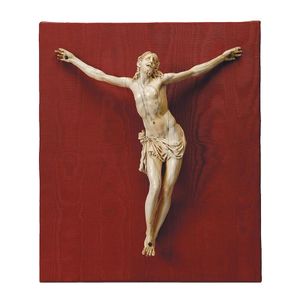17/18th Century Ivory Corpus Christi on Crimson Panel
You must be a subscriber, and be logged in to view price and dealer details.
Subscribe Now to view actual auction price for this item
When you subscribe, you have the option of setting the currency in which to display prices to $Au, $US, $NZ or Stg.
- Ivory - Ivory is a hard white material that comes from the tusks of elephants, mammoth, walrus and boar, or from the teeth of hippopotamus and whales. The ivory from the African elephant is the most prized source of ivory. Although the mammoth is extinct, tusks are still being unearthed in Russia and offered for sale.
Ivory has been used since the earliest times as a material for sculpture of small items, both in Europe and the east, principally China and Japan.
In Asia ivory has been carved for netsuke, seals, okimono, card cases, fan supports, animals and other figures and even as carved tusks.
In the last 200 years in Europe ivory has been used to carve figures, for elaborate tankards, snuff boxes, cane handles, embroidery and sewing accessories, in jewellery and as inlay on furniture. Its more practical uses include being used for billiard balls, buttons, and a veneers on the top of piano keys.
The use and trade of elephant ivory have become controversial because they have contributed to Due to the decline in elephant populations because of the trade in ivory, the Asian elephant was placed on Appendix One of the Convention on International Trade in Endangered Species (CITES), in 1975, and in January 1990, the African elephant was similarly listed. Under Appendix One, international trade in Asian or African elephant ivory between member countries is forbidden. Unlike trade in elephant tusks, trade in mammoth tusks is legal.
Since the invention of plastics, there have been many attempts to create an artificial ivory
This item has been included into following indexes:
- religious objects, Christian
Visually similar items

A pearl platypus brooch, the finely crafted platypus, featuring a blister pearl, in a textured surround in 18ct gold.

Art Deco alabaster figure of a nude, depicted standing with one hand on head, the other holding a robe at her feet, raised on square pedestal base, a/f, height 25 cm

Ceramic dancer stamped to base 'Hutschenreuther Germany, Kunstassteilung', height 21 cm. Provenance: Orlando Brown Collection, Mosman

18ct white gold, diamond and sapphire pendant/brooch, Salavetti, modelled as a seated cat pave-set with brilliant-cut diamonds, the eyes and bow tie embellished with circular-cut sapphires, the diamonds and sapphires together weighing approximately 2.31 ca
